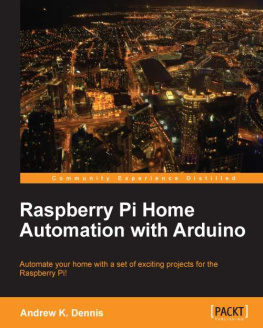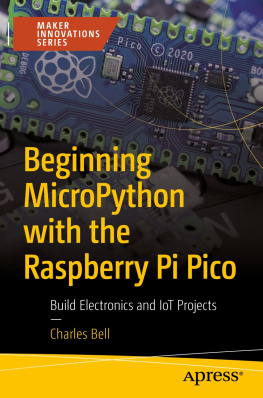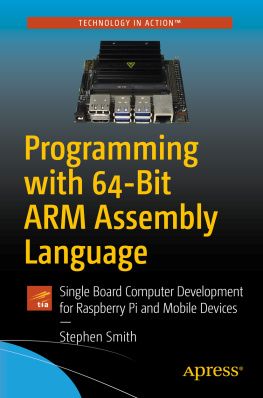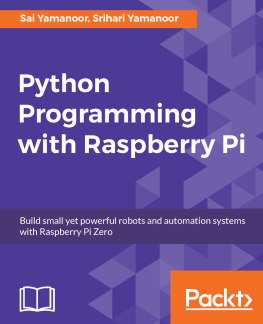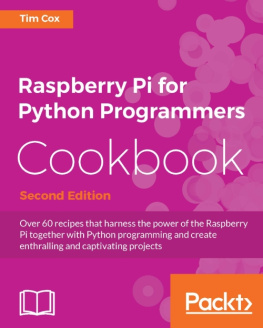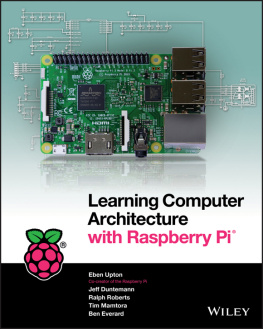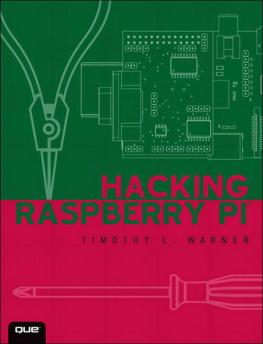Dennis - Raspberry Pi Computer Architecture Essentials
Here you can read online Dennis - Raspberry Pi Computer Architecture Essentials full text of the book (entire story) in english for free. Download pdf and epub, get meaning, cover and reviews about this ebook. City: Birmingham, year: 2016, publisher: Packt Publishing - ebooks Account;Packt Publishing Ltd, genre: Home and family. Description of the work, (preface) as well as reviews are available. Best literature library LitArk.com created for fans of good reading and offers a wide selection of genres:
Romance novel
Science fiction
Adventure
Detective
Science
History
Home and family
Prose
Art
Politics
Computer
Non-fiction
Religion
Business
Children
Humor
Choose a favorite category and find really read worthwhile books. Enjoy immersion in the world of imagination, feel the emotions of the characters or learn something new for yourself, make an fascinating discovery.

- Book:Raspberry Pi Computer Architecture Essentials
- Author:
- Publisher:Packt Publishing - ebooks Account;Packt Publishing Ltd
- Genre:
- Year:2016
- City:Birmingham
- Rating:5 / 5
- Favourites:Add to favourites
- Your mark:
Raspberry Pi Computer Architecture Essentials: summary, description and annotation
We offer to read an annotation, description, summary or preface (depends on what the author of the book "Raspberry Pi Computer Architecture Essentials" wrote himself). If you haven't found the necessary information about the book — write in the comments, we will try to find it.
- Explore Raspberry Pi 2s hardware through the Assembly, C/C++, and Python programming languages
- Experiment with connecting electronics up to your Raspberry Pi 2 and interacting with them through software
- Learn about the Raspberry Pi 2 architecture and Raspbian operating system through innovative projects
With the release of the Raspberry Pi 2, a new series of the popular compact computer is available for you to build cheap, exciting projects and learn about programming.
In this book, we explore Raspberry Pi 2s hardware through a number of projects in a variety of programming languages. We will start by exploring the various hardware components in detail, which will provide a base for the programming projects and guide you through setting up the tools for Assembler, C/C++, and Python. We will then learn how to write multi-threaded applications and Raspberry Pi 2s multi-core processor. Moving on, youll get hands on by expanding the storage options of the Raspberry Pi beyond the SD card and interacting with the graphics hardware. Furthermore, you will be introduced to the basics of sound programming while expanding upon your knowledge of Python to build a web server. Finally, you will learn to interact with the third-party microcontrollers.
From writing your first Assembly Language application to programming graphics, this title guides you through the essentials.
What you will learn- Set up your Raspberry Pi 2 and learn about its hardware
- Write basic programs in Assembly Language to learn about the ARM architecture
- Use C and C++ to interact with electronic components
- Find out about the Python language and how to use it to build web applications
- Interact with third-party microcontrollers
- Experiment with graphics and audio programming
- Expand Raspberry Pi 2s storage mechanism by using external devices
- Discover Raspberry Pi 2s GPIO pins and how to interact with them
Andrew K. Dennis is the manager of professional services software development at Prometheus Research. Prometheus Research is a leading provider of integrated data management for research and is the home of HTSQL, an open source navigational query language for RDBMS.
Andrew has a diploma in computing, a BSc in software engineering, and is currently studying for a second BSc in creative computing in his spare time.
He has over 12 years of experience working in the software industry in the UK, Canada, and the USA. This experience includes e-learning courseware development, custom CMS and LMS development, SCORM consultancy, web development in a variety of languages, open source application development, blogging about the integration of web technologies with electronics for home automation, and punching lots of Cat5 cables.
His interests include web development, e-learning, 3D printing, Linux, the Raspberry Pi and Arduino, open source projects, home automation and the use of web technology in this sphere, amateur electronics, home networking, and software engineering.
Table of Contents- Introduction to the Raspberry Pis Architecture and Setup
- Programming on Raspbian
- Low-Level Development with Assembly Language
- Multithreaded Applications with C/C++
- Expanding on Storage Options
- Low-Level Graphics Programming
- Exploring the Raspberry Pis GPIO Pins
- Exploring Sound with the Raspberry Pi 2
- Building a Web Server
- Integrating with Third-Party Microcontrollers
- Final Project
Dennis: author's other books
Who wrote Raspberry Pi Computer Architecture Essentials? Find out the surname, the name of the author of the book and a list of all author's works by series.


